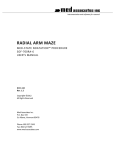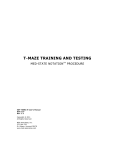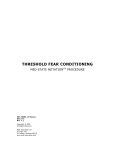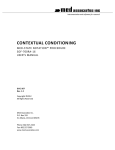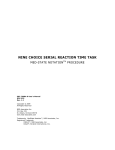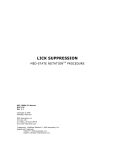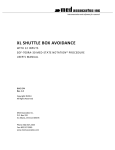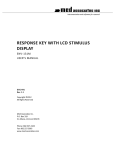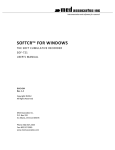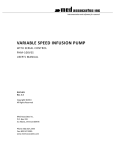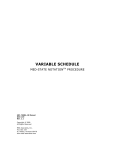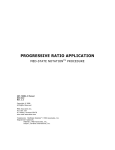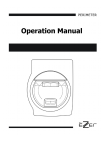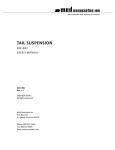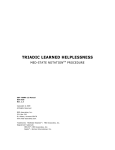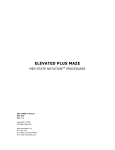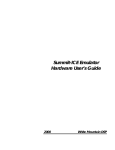Download Med Associates Product Manual
Transcript
instrumentation and software for research FIVE CHOICE SERIAL REACTION TIME TASK SOF-700RA-8A USER’S MANUAL DOC-026 Rev. 1.3 Copyright ©2012 All Rights Reserved Med Associates Inc. P.O. Box 319 St. Albans, Vermont 05478 Phone: 802.527.2343 Fax: 802.527.5095 www.med-associates.com Trademarks: MedState Notation™, MED Associates, Inc. Registered Trademark: MED-PC ® , MED Associates, Inc. Delphi ® , Borland International, Inc. SOF-700RA-8A 5CSRT notes i SOF-700RA-8A 5CSRT Table of Contents Chapter 1 | Introduction ................................................................................................ 1 Overview of the Procedure .......................................................................................................... 2 Chapter 2 | Software Installation ................................................................................ 3 Software Installation..................................................................................................................... 3 Backing Up the Software.............................................................................................................. 3 Chapter 3 | Beginning & Running an Experiment .................................................... 4 Translating the MED-PC IV (.mpc) File ...................................................................................... 4 Using the MED-PC IV Load Wizard ............................................................................................. 5 Viewing/Changing Variable Values ........................................................................................... 10 Changing Stimulus Duration and ITI Variables ...................................................................... 12 Macros........................................................................................................................................... 13 Modifying the MedState Notation™ Code................................................................................ 13 Using Multiple Stimulus Duration Times .................................................................................. 14 Using Less Than Five Nose Pokes ............................................................................................ 15 Chapter 4 | Understanding the Data Files................................................................ 16 Sample Data File ......................................................................................................................... 16 Breakdown of Sample File - Simple Variables......................................................................... 18 Breakdown of Sample File - Arrays .......................................................................................... 18 Array A .......................................................................................................................................... 18 Array B .......................................................................................................................................... 19 Array G.......................................................................................................................................... 21 Array K .......................................................................................................................................... 22 Array N.......................................................................................................................................... 22 Arrays P through T ...................................................................................................................... 23 Array Z .......................................................................................................................................... 23 Appendix A | Contact Information............................................................................. 23 ii MED ASSOCIATES INC. SO F - 7 0 0 R A - 8 A 5 C SR T CHAPTER 1 | INTRODUCTION The purpose of this manual is to give an explanation of the MED State Notation™ Procedures that comprise the SOF-700RA-8A Five Choice Serial Reaction Time Procedure. The files in this package can be found on the disk provided by MED Associates, Inc. These procedures are intended to be run in MED Associates MED-PC® IV software. The latest version of MED-PC® IV gives researchers the ability to use pre-programmed procedures such as these to make hardware control and data collection easy. These pre-programmed procedures can also be modified to meet the evolving demands of a research protocol. Again, it is the intent of this manual to explain exactly what these procedures implement, and provide guidance into how to interpret what the program code achieves in order to let the user determine how to modify them to match their research protocol demands. The manual provides some examples of editing and modifying the procedure’s programming code. The manual also defines the elements in the raw data file produced by these procedures. In addition to this manual, refer to the MED-PC® IV User’s Manual for the installation of the MED-Associates interface drivers, the MED-PC IV Software, and the Delphi® Compiler. Also refer to the User’s Manual for instructions on developing a Hardware Configuration. Data file structure, file-saving format, and other related options are also determined by the Hardware Configuration. Running the Hardware Configuration software utility that accompanies MED-PC IV sets the Hardware Configuration. Its purpose is to assign the inputs and outputs on the interface cards in the interface cabinet for each task controlled by MED-PC IV. The particular type of interface card that is supplied in the interface cabinet may vary; please refer to the User’s Manual provided for instructions on how to configure the type of card that is in the cabinet. A valid Hardware Configuration must exist in order for MED-PC IV to interface correctly with the MED Associates, Inc. hardware. This means that one should take the time to create a valid Hardware Configuration before attempting to run the procedures included in this package. Should there be any problems, the staff at MED Associates, Inc. is available to answer any questions that may arise. Please e-mail us at [email protected] with a detailed description of the problem or desired goals so that concise and detailed information may be provided. The Five Choice Serial Reaction Time procedure is designed to be as easy to use as possible. MED Associates, Inc. understands that researchers do not have the time to devote to programming and hardware design, and for that reason, we have undertaken that burden for you. We sincerely hope that you are satisfied with the products and services we provide, and look forward to meeting your future experimental needs as your research program evolves. -1DOC-026 Rev 1.3 Copyright © 2012 MED Associates, Inc. MED ASSOCIATES INC. SO F - 7 0 0 R A - 8 A 5 C SR T Overview of the Procedure The test animal is required to respond to brief flashes of light presented randomly in one of five spatial locations. (Testing with fewer than five locations is also possible and is covered in the Modifying the MedState Notation™ Code section of this manual.) Testing begins with the onset of the House Light and the Pellet or Dipper Receptacle Light. A response issues a Free Reward Presentation and initiates the Session Timer. Following the Reward Interval an ITI is activated for the first Trial. Responses during the ITI result in a Time Out and are recorded as a Premature Response. Time Outs also occur following an Incorrect Response, or following an Error of Omission (failure to respond within the Limited Hold Interval). Responses during the Time Out reset the Time-Out Timer. The house light is turned off during a Time Out. A correct response turns the receptacle light on; however, the Reward Duration time does not start until a head entry is made. Spurious head entries are counted during all intervals. Twenty elements of data are recorded for each trial. Responses are counted in six summary elements plus total head entries. The percentage of correct, incorrect, and omissions is calculated, as is average latency to correct responses, average latency to incorrect responses, and average latency to reward. By default this procedure runs for 50 trials or 30 minutes starting with a fixed ITI Interval of 5 seconds and fixed Stimulus Duration of 0.5 seconds. Both the ITI and the Stimulus Duration can be randomized by adding to the LIST statements (see Modifying the MedState Notation™ Code). If the session should continue through the last trial regardless of the amount of time it takes, simply set the session time to some excessive value such as 999. The maximum number of trials that can be run is 250 due to the size of the “K” array; however, this can be easily changed to accommodate additional trials. The variable values are set to the following default values (see Viewing/Changing Variable Values to change these values). Table 1.1 - Default Variable Values Variable Default Value Trials to Run (maximum of 250) 50 (10 presentations at each stimulus location) Response (Limited Hold) Time (seconds) 5 Time Out (seconds) 5 Reward (1 = Pellet; 2 = Dipper) 1 Reward Duration (seconds) 2 Session Time (minutes) 30 -2DOC-026 Rev 1.3 Copyright © 2012 MED Associates, Inc. MED ASSOCIATES INC. SO F - 7 0 0 R A - 8 A 5 C SR T CHAPTER 2 | SOFTWARE INSTALLATION Software I nstall ation Please refer to the MED-PC IV User’s Manual for a complete guide to installing the MED-PC IV software, building a valid Hardware configuration with the Hardware Configuration utility, and opening and compiling a MSN procedure in the Trans-IV utility. To install the Five Choice Serial Reaction Time Task Procedure, insert the CD into the CD-ROM drive and click Install the 5 Choice Serial Reaction Time Software. The procedure is copied into the C:\MED-PC IV\MPC folder. Backing Up the Softw are Med Associates strongly encourages creating backup copies of the programs in case of disk failure. Having copies of the original programs may be useful in the future should modifications be made to the existing programs. -3DOC-026 Rev 1.3 Copyright © 2012 MED Associates, Inc. MED ASSOCIATES INC. SO F - 7 0 0 R A - 8 A 5 C SR T CHAPTER 3 | BEGINNING & RUNNIN G AN EXPERIMENT Translati ng the MED -PC IV (.mpc) File Programs written in MedState Notation must be translated using Trans IV before they can be executed in this application. Be sure that a copy of the file being translated is present in the directory “C:\MED-PC IV\MPC\.” Open Trans IV icon and select Translation | Translate and Compile. Select the program(s) to use for the experiment and click Make. Click OK to start the translator, and it will automatically parse the MedState Notation and then open to a DOS screen to compile the Pascal code. Depending on the speed of the computer, each of these steps may not be seen. If any problems are encountered during this process, refer to the on-screen help menu or the MED-PC Version IV User’s Manual, or contact MED Associates, Inc. for assistance. Figure 3.1 - Trans IV Control Panel for Translating and Compiling MedState Notation Code -4DOC-026 Rev 1.3 Copyright © 2012 MED Associates, Inc. MED ASSOCIATES INC. SO F - 7 0 0 R A - 8 A 5 C SR T Using the MED -PC IV Load Wizar d MED-PC IV is designed to help the researcher run an experiment by guiding selection choices through its Experiment Loading Wizard. This section will describe how to initiate the 5CSRT.mpc application, however the following steps that will also apply to all other .mpc procedures. Open MED-PC IV and the MED-PC Experiment Loading Wizard’s Welcome screen, shown in Figure 3.2 will appear. Figure 3.2 - The MED-PC IV Loading Wizard Welcome Screen To avoid this load wizard, deselect the checkbox labeled Run this experiment automatically when starting MED-PC. Close this screen by clicking the Close button. Closing this screen immediately reveals the MED-PC Run-Time Screen shown in Figure 3.9. If the choice to continue with the Loading Wizard is made, then click the Next button. -5DOC-026 Rev 1.3 Copyright © 2012 MED Associates, Inc. MED ASSOCIATES INC. SO F - 7 0 0 R A - 8 A 5 C SR T The Box Selection screen will appear next, as shown in Figure 3.3. From this screen the researcher chooses which boxes will be used in the experiment. Select the boxes that will run the experiment by clicking in the radio button next to the box number. The figure shows that the Hardware Configuration included only 1 box, which was selected. Click Next to continue. Figure 3.3 - The Box Selection Screen The Select a Procedure screen appears next, as seen in Figure 3.4. This is where the application to be run is selected. The screen displays a list of all the currently compiled procedures. Select the desired procedure and then click Next. Figure 3.4 - The Select a Procedure Screen -6DOC-026 Rev 1.3 Copyright © 2012 MED Associates, Inc. MED ASSOCIATES INC. SO F - 7 0 0 R A - 8 A 5 C SR T The Enter Experiment Data Screen should display next, as shown in Figure 3.5. The purpose of this screen is to allow annotations to be added to the data file that is produced by MED-PC IV. These annotations will help identify the Subject, Experiment, and Experiment Group upon which data was collected. Comments can be added here as well, and the data file can be given a customized file name to help identify it from other data files. Enter the information desired, and click Next. Figure 3.5 - Enter Experiment Data Screen The next screen to appear is the Review Choices screen, as seen in Figure 3.6. This is a method of confirming that the information received from the Box/Procedure Selected is correct. If it is not correct, select Previous, and edit the data. If it is correct, select Next. Figure 3.6 - Review Choices Screen -7DOC-026 Rev 1.3 Copyright © 2012 MED Associates, Inc. MED ASSOCIATES INC. SO F - 7 0 0 R A - 8 A 5 C SR T The Alter Session Parameters Screen, shown in Figure 3.7, is the next screen to appear, and is an important screen for the researcher. The Alter Session Parameters screen allows the researcher to alter the parameters by which a procedure executes. The Send Start Command Screen appears next. The options available on the screen vary depending upon how many boxes are described in the Hardware Configuration. Figure 3.7 - Alter Session Parameters Screen In this example only 1 box is described in the Hardware Configuration, so Figure 3.8 will appear next. If more than 1 box is in the Hardware Configuration, then Figure 3.9 will appear. Figure 3.8 - Send Start Command Screen for Single Box Configuration -8DOC-026 Rev 1.3 Copyright © 2012 MED Associates, Inc. MED ASSOCIATES INC. SO F - 7 0 0 R A - 8 A 5 C SR T Figure 3.9 - Send Start Command Screen for Multiple Box Configuration In both cases (Figure 3.8 and Figure 3.9), the screens are where the researcher decides to either load more boxes, send a start signal to boxes that are already loaded, or enter the MED-PC IV run-time environment without sending a start signal by selecting “I am finished with the wizard”. This option results in the screen shown in Figure 3.10. Figure 3.10 - The MED-PC IV Run-Time Screen -9DOC-026 Rev 1.3 Copyright © 2012 MED Associates, Inc. MED ASSOCIATES INC. SO F - 7 0 0 R A - 8 A 5 C SR T Viewing/Changing Var iable Val ues Before a “start command” has been issued, any variable may be changed on the MED-PC IV runtime screen. Simply highlight the value to change, and then enter the new value. Once a session is in progress, change variables by selecting Configure | Change Variables, or click the 4th tool bar item X. In the lower left hand corner of the Change Variables window, find the “Display Data from Box” display, and choose the chamber(s) to modify. By clicking additional boxes in the “Additional Boxes to Update” section, changes made to a single box are automatically loaded to all of the selected boxes. Figure 3.11 - Changing Variables Screen The value of any simple variable may be viewed from this screen by clicking an array on the table and each element in that array can be viewed, as shown in Figure 3.12. To change a value, simply highlight and replace the value in the lower right hand box or use the up/down arrows to increment by 1. Click the Issue button for the change to take effect. Click Named Variables to produce the display in Figure 3.13. Change variables here as needed. - 10 DOC-026 Rev 1.3 Copyright © 2012 MED Associates, Inc. MED ASSOCIATES INC. SO F - 7 0 0 R A - 8 A 5 C SR T Figure 3.12 - Displaying Array A from Box 1 Figure 3.13 - Displaying Named Variables from Box 1 - 11 DOC-026 Rev 1.3 Copyright © 2012 MED Associates, Inc. MED ASSOCIATES INC. SO F - 7 0 0 R A - 8 A 5 C SR T Changing Stimulus Duration and ITI Variabl es Arrays were used to control stimulus duration and ITI durations, because it may be desirable to randomize multiple values of one or the other or both. The default stimulus duration for each stimulus location has been placed in an individual array in order to produce a balanced design when using multiple durations. The stimulus duration value for Stimulus 1 is in the P Array. To change this value, click the P Array button on the Change Variables screen (Figure 3.11) to produce the display in Figure 3.14. Highlight and replace the value in the lower right hand box. Click “Issue” for the change to actually take effect. Figure 3.14 - Changing the Duration of Stimulus 1 In Figure 3.14, the value of the stimulus duration for location 1 has been changed to 3 seconds. To change all locations to the same value you must repeat this procedure for arrays Q, R, S, and T. If you plan to run the same time for many sessions, it is more efficient either to edit the code and retranslate it with a new file name or to create a macro as illustrated below. Use the same procedure to change the ITI value(s) in the Z Array. - 12 DOC-026 Rev 1.3 Copyright © 2012 MED Associates, Inc. MED ASSOCIATES INC. SO F - 7 0 0 R A - 8 A 5 C SR T Macros The simplest way to initially create a macro is to record keyboard functions while performing the steps manually. Once the commands are in the macro, it is easy to create a number of macros with the macro editor. The following example illustrates the process of loading “Box 1” and changing the Stimulus Duration to 3 seconds. To begin, open MED-PC IV and going directly to the run time screen. Close the load wizard, if present. Before loading or opening the procedure, click Macro on the main menu and select Turn On Macro Recorder or click the 8th tool bar item with the cassette tape icon on top. A note on the bottom of the display indicates that the recorder is running. Open “5CSRT.mpc” by clicking Files | Open Session. Change the variables using any of the methods described above. When all settings have been made, turn the recorder off again by using the main menu or tool bar. Save the macro with a distinctive name. The example in Figure 3.15 was named “Load5CSRT_3sec.mac” since the stimulus duration was changed to 3 seconds. Figure 3.15 – Load5CSRT_3sec.mac Once this macro is built, use the macro editor to make simple changes such as replacing all 3second values with 5-second values. Review the Help file on screen or the User’s Manual for more information on macros and the features offered. A START command or message box followed by a START command could be added to the macro. It was left off here so changes could be verified before starting the procedure. Modifying the MedState Notation™ Code Permanent changes to the MedState Notation code. To make the same change to the stimulus duration as shown above, do the following. Open Trans IV and select File | Open to place 5CSRT.mpc into the text editor. Scroll down to approximately line 133 (note the line counter in the lower right hand corner of the editor) to reveal the code shown in Figure 3.16. - 13 DOC-026 Rev 1.3 Copyright © 2012 MED Associates, Inc. MED ASSOCIATES INC. SO F - 7 0 0 R A - 8 A 5 C SR T Figure 3.16 – 5CSRT.mpc Line 133 Change each “0.5” value to “3.0” and save the changes with the same or a new file name such as 5CSRT_3.mpc. Remember a new .mpc file name is created and are a macro is being used to load boxes, the file name in the macro also must be changed. Translate and compile the new or changed file as described previously and run MED-PC IV. Use the Change Variables screen to view/confirm the new values. Using Multi ple Stimul us Dur ation Times Running multiple stimulus values is also a simple editing change to the code. Simply add the additional values to the LIST statement as shown in Figure 3.17. Figure 3.17 - MSN Code from 5CSRT.mpc with Multiple Stimulus Durations The new arrays are automatically dimensioned and the values drawn at random for each new trial. If the total number of trials is an even multiple of 5 times the number of duration values, an equal number of trials at each value and location runs. The duration factor may be analyzed by exporting data from the D Array to Microsoft ExcelTM and sorting by duration. The MED Associates’ utility MPC2XL may be useful if exporting data from multiple files or partial data. - 14 DOC-026 Rev 1.3 Copyright © 2012 MED Associates, Inc. MED ASSOCIATES INC. SO F - 7 0 0 R A - 8 A 5 C SR T Using Less Than Five Nose Pokes Running fewer than five Nose Pokes is sometimes desirable, especially during training. The editing, translating, and compiling process is the same as described above. The critical code may be found around line 125, where the following may be found: LIST N = 1,2,3,4,5 The stimulus location for each trial is drawn from this list, so the follow changes are appropriate. Example 1: LIST N = 3 This runs a single stimulus in the center nose poke only. Note that in some instances it is also desirable to physically cover the unused nose pokes. Cover plates are available for this purpose on request. Example 2: LIST N = 2,3,4 \ Run with the three adjacent center locations Example 3: LIST N = 1,3,5 \ Run three locations using every other stimulus - 15 DOC-026 Rev 1.3 Copyright © 2012 MED Associates, Inc. MED ASSOCIATES INC. SO F - 7 0 0 R A - 8 A 5 C SR T CHAPTER 4 | UNDERSTANDING THE DA TA FILES Unless otherwise specified, data will be saved to C:\MED-PC IV\DATA. Data can be saved manually by selecting FILE | SAVE DATA MANUALLY or FILE | SAVE DATA (FLUSH). The file name that is used to save the data in depends on the option that was chosen in the Hardware Configuration Utility and may also be dependent on the Subject, Experiment, and Group name provided in the MED-PC IV load wizard. Within each data file, the headings are created for each Subject, Experiment, Group, Box, etc., (see below). Data files may be opened with note pad, word pad, or any word processor or spreadsheet; however, be sure they are always saved “unformatted” in case a data extraction utility such as MED-PC to Excel might ever be used. Data file formats are explained in detail in the MED-PC IV User’s Manual. Sample Data File Select Annotated on the file options page during hardware installation to produce a raw data file similar to the following. Data files are located in C:\MED-PC IV\Data\ unless an alternate path was defined during hardware installation. They may be opened with note pad, word pad, or any word processor; however, make sure they are always saved unformatted in the occasion a data extraction utility such as MPC2XL is used. The header information should be selfexplanatory. Data-file formats are explained in detail in the MED-PC IV User’s Manual. File: C:\MED-PC IV\DATA\!2003-02-12_10h26m.Subject 0 Start Date: 02/12/03 End Date: 02/12/03 Subject: 0 Experiment: 0 Group: 0 Box: 1 Start Time: 10:26:23 End Time: 10:29:30 MSN: 5CSRT C: 0.00 E: 0.00 F: 0.00 H: 0.00 I: 0.00 J: 0.00 L: 0.00 M: 0.00 O: 0.00 U: 0.00 V: 0.00 W: 0.00 X: 0.00 Y: 0.00 A: 0: 50.00 5.00 5.00 1.00 2.00 30.00 - 16 DOC-026 Rev 1.3 Copyright © 2012 MED Associates, Inc. MED ASSOCIATES INC. SO F - 7 0 0 R A - 8 A 5 C SR T B: 0: 50.00 500.00 500.00 0.00 200.00 158.00 4.51 2.00 100.00 500.00 0: 10: 5.00 55.56 3.00 33.33 1.00 11.11 2.00 2.00 4.00 5.00 0.00 0: 3.05 1.41 6.33 0.00 0.00 15.26 4.23 31.63 0: 10: 20: 30: 40: 50: 60: 70: 80: 90: 100: 110: 120: 130: 140: 150: 160: 170: 1.00 0.00 2.00 0.00 3.00 0.00 4.00 0.00 5.00 0.00 6.00 0.00 7.00 0.00 8.00 0.00 9.00 0.00 3.00 0.00 7.00 0.00 1.00 0.00 4.00 0.00 6.00 0.00 8.00 0.00 9.00 0.00 5.00 0.00 2.00 0.00 3.00 0.00 3.00 0.00 1.00 0.00 0.00 0.00 6.00 0.00 8.00 0.00 1.00 0.00 4.00 0.00 2.00 0.00 3.03 0.00 0.00 0.00 2.38 0.00 0.00 0.00 3.01 0.00 3.30 0.00 0.00 0.00 0.00 0.00 3.54 0.00 0.00 0.00 2.70 0.00 0.00 0.00 0.00 0.00 0.00 0.00 0.00 0.00 0.14 0.00 1.39 0.00 0.00 0.00 8.59 0.00 0.00 0.00 10.17 0.00 0.00 0.00 5.72 0.00 2.64 0.00 0.00 0.00 0.00 0.00 4.51 0.00 0.00 0.00 0.00 0.00 0.00 0.00 1.00 0.00 0.00 0.00 0.00 0.00 0.00 3.00 0.00 3.00 0.00 0.00 0.00 1.00 0.00 0.00 1.00 1.00 0.00 0.00 0.00 1.00 0.00 1.00 0.00 0.00 0.00 0.00 0.00 1.00 0: 1.00 2.00 3.00 4.00 5.00 0: 1.00 0: 1.00 0: 1.00 0: 1.00 0: 1.00 0: 5.00 5.00 5.00 D: 0.00 0.00 0.00 1.00 0.00 1.00 1.00 1.00 0.00 1.00 0.00 1.00 0.00 1.00 0.00 1.00 0.00 1.00 0.00 1.00 0.00 5. 00 0.00 5.00 0.00 5.00 0.00 5.00 0.00 5.00 0.00 5.00 0.00 5.00 0.00 5.00 0.00 5.00 G: K: N: P: Q: R: S: T: Z: - 17 DOC-026 Rev 1.3 Copyright © 2012 MED Associates, Inc. MED ASSOCIATES INC. SO F - 7 0 0 R A - 8 A 5 C SR T Breakdown of Sample File - Simple Variables The following simple variables are shown immediately following the header information: C: E: F: H: I: J: L: M: O: U: V: W: X: Y: 0.00 0.00 0.00 0.00 0.00 0.00 0.00 0.00 0.00 0.00 0.00 0.00 0.00 0.00 There are no simple variable used in this application and so unused the elements are reported with value “0”. Breakdown of Sample File - Arrays The arrays are presented in rows of 10 elements each. The first row begins with element 0 and ends with element 9, the second row begins with element 10 and ends with element 19, etc. Each row begins with an element marker followed by a colon, 0:, 10:, 20:, 30:, etc. The number of elements or columns in each row is controlled by the command DISKCOLUMNS = 10 found at line 154 of the MedState Notation code. Ten elements per row were selected because in array K there are 20 elements per trial. Unused elements in summary data files could be used to meet future requirements. Array size may be expanded with the DIM commands found prior to State Set 1. Each array has been defined in the comments section at the beginning of the .mpc file. That information was used to add the following labels to each array. The lines were expanded to make room for the labels. See the MPC2XL User’s Manual for producing labeled data files with all or just some of the information below. Array A Array A contains the control variable values. The values are preset to default values in State Set 1, State 1. They are displayed as named variables and can be changed by any of the methods described previously. Once a session is started these values should not be changed to insure the integrity of the experiment. A: 0: 50.00 5.00 5.00 1.00 2.00 30.00 - 18 DOC-026 Rev 1.3 Copyright © 2012 MED Associates, Inc. MED ASSOCIATES INC. SO F - 7 0 0 R A - 8 A 5 C SR T Array A with Labels Row Marker 0: A(0) A(1) A(2) A(3) A(4) A(5) Trials to Run Limited Hold Time Out Reward Code Reward Duration Session Time 50 5 5 1 2 30 Array B Array B parallels Array A and is used for the working variables that may change as the session runs. For example, the element for Trials is incremented by one for each trial. At the end of the session, the value will be the same as the A element unless the experiment ran out of time. The session time in the B Array is incremented in seconds while the value in the A array is set in minutes. The time elements for limited hold, time out and reward duration are in MED clock units. Since this example was run with a resolution setting of 10 ms, the values in the B Array are 100 times the values in the A Array, which are in seconds. B: 0: 50.00 500.00 500.00 0.00 200.00 158.00 4.51 2.00 100.00 Array B with Labels Row Marker 0: B(0) B(1) B(2) B(3) B(4) B(5) B(6) Trials to Run Limited Hold Time Out Not Used Reward Duration Session Time Latency Time 50 500 500 0 200 158 4.51 B(7) B(8) Stimulus Stimulus Location Duration 2 100 - 19 DOC-026 Rev 1.3 Copyright © 2012 MED Associates, Inc. MED ASSOCIATES INC. SO F - 7 0 0 R A - 8 A 5 C SR T Array D Array D contains some summary information. The counters in elements D(0) through D(6) provide total responses broken down by category, as well as head entry counts. To see exactly when each counter is incremented, run “Find” or “Search” in the Medstate Notation text file on the element label. For example, a search on “D(0)” takes you to any statement in which a correct response is incremented or displayed. The values in elements D(10) through D(12) are calculated at the end of each trial and are displayed as a percentage. Adding these three numbers together should total 100%. Rounding could cause it to be off by +/- 0.01. In the sample file of 50 trials there were 28 correct and 17 incorrect responses with five trials of omission, or 56.00% correct, 34.00% incorrect, and 10.00% omission. There were also 2 premature responses, 2 perseverant responses, 4 time out responses, and 5 head entries. D: 0: 28.00 17.00 5.00 10: 56.00 34.00 10.00 2.00 2.00 4.00 5.00 0.00 0.00 0.00 Array D with Labels Row Marker 0: Row Marker 10: D(0) D(1) D(2) D(3) D(4) D(5) D(6) D(7) D(8) D(9) Correct Responses Incorrect Responses Omissions Premature Responses Perseverant Responses Time Out Responses Head Entries Not Used Not Used Not Used 28 17 5 2 2 4 5 0 0 0 D(10) D(11) D(12) Percent Correct Percent Incorrect Percent Omission 56.00 34.00 10.00 - 20 DOC-026 Rev 1.3 Copyright © 2012 MED Associates, Inc. MED ASSOCIATES INC. SO F - 7 0 0 R A - 8 A 5 C SR T Array G Array G contains additional summary data. G(0), G(1), and G(2) contain the average latency to correct, incorrect, and omissions respectively. G(5), G(6), and G(7) contain the total latency times from which the averages were computed, but otherwise provide no additional information. For example, the value of G(0), 0.55, is the result of dividing the total latency time in G(5), 15.26, by the total number of correct responses in D(0), 28. The number of decimals shown is controlled by the DISKFORMAT command inserted into the code prior to State Set 1. G: 0: 0.55 0.25 6.33 0.00 0.00 15.26 4.23 31.63 Array G with Labels G(0) G(1) G(2) G(3) Row Marker Average Latency Correct Average Latency Incorrect Average Latency Reward Not Used 0: 0.55 0.25 6.33 0 G(4) Not Used 0 G(5) G(6) G(7) Total Latency Correct Total Latency Incorrect Total Latency Reward 15.26 4.23 31.63 - 21 DOC-026 Rev 1.3 Copyright © 2012 MED Associates, Inc. MED ASSOCIATES INC. SO F - 7 0 0 R A - 8 A 5 C SR T Array K Array K contains trial-by-trial information. A total of 20 elements are assigned to each trial and are displayed in two rows. Only the data from the first four trials is shown below. By comparing the stimulus location with the location of the first response you can tell what type of trial each was. The locations match for the correct trials 1 & 3 and do not match for incorrect trial 2. In trial 4, the response location is 0 indicating an omission trial. To view only those trials that meet a specific criterion, place this data in a spreadsheet with one row per trial and sort to extract all correct or incorrect trials, all trials in a particular location, or trials by stimulus duration when using multiple durations. K: 0: 10: 20: 30: 40: 50: 60: 70: 1.00 0.00 2.00 0.00 3.00 0.00 4.00 0.00 3.00 0.00 7.00 0.00 1.00 0.00 4.00 0.00 3.00 0.00 3.00 0.00 1.00 0.00 0.00 0.00 3.03 0.00 0.00 0.00 2.38 0.00 0.00 0.00 0.00 0.00 2.70 0.00 0.00 0.00 0.00 0.00 8.59 0.00 0.00 0.00 10.17 0.00 0.00 0.00 0.00 0.00 0.00 0.00 0.00 0.00 1.00 0.00 0.00 1.00 0.00 0.00 1.00 1.00 0.00 0.00 0.00 1.00 0.00 1.00 1.00 1.00 0.00 1.00 0.00 5.00 0.00 5.00 0.00 5.00 0.00 5.00 Array K with Labels Row Marker K(0) K(1) K(2) K(3) K(4) K(5) K(6) K(7) K(8) K(9) Trial Number Stimulus Location First Response Correct Latency Incorrect Latency Reward Latency Omission Error Perseverant NP #1 Perseverant NP #2 Perseverant NP #3 0: 1 3 3 3.03 0 8.59 0 0 0 0 K(12) K(13) K(14) K(15) K(16) K(17) K(18) K(19) Head Entries Cue Duration ITI Duration K(10) K(11) Perseverant NP #4 Perseverant NP #5 Not Used Not Used Not Used Not Used Premature Response 10: 0 0 0 0 0 0 0 1 1 5 20: 2 7 3 0 2.7 0 0 0 0 0 30: 0 0 0 0 0 0 0 0 1 5 40: 3 1 1 2.38 0 10.17 0 1 1 0 50: 0 0 0 0 0 0 0 1 1 5 60: 4 4 0 0 0 0 1 0 0 0 70: 0 0 0 0 0 0 0 0 1 5 Array N Array N contains a list of stimulus locations. N: 0: 1.00 2.00 3.00 4.00 5.00 - 22 DOC-026 Rev 1.3 Copyright © 2012 MED Associates, Inc. MED ASSOCIATES INC. SO F - 7 0 0 R A - 8 A 5 C SR T Arrays P through T Arrays P through T contain the lists of cue durations for nose pokes 1 through 5. P: 0: 0.50 0: 0.50 0: 0.50 0: 0.50 0: 0.50 Q: R: S: T: Array Z Array Z contains the list of ITI durations. Z: 0: 5.00 5.00 5.00 Appendix A | Contact Information Please contact MED Associates, Inc. for information regarding any of our products. Visit our website at www.med-associates.com for contact information. For technical questions, email [email protected]. - 23 DOC-026 Rev 1.3 Copyright © 2012 MED Associates, Inc.


























